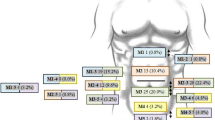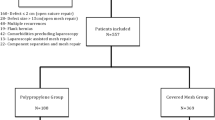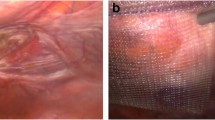Abstract
Background
Laparoscopic ventral or incisional hernia repair requires intraperitoneal mesh placement. This is associated with an increase in adhesions, bowel obstruction and enterocutaneous fistula. Intraabdominal meshes are laparoscopically fixed using traumatic fixation methods that increase acute, chronic pain and adhesions to bowel loops. The aim was to check the safety and effectiveness of the laparoscopic approach in ventral or incisional hernia, using a self-adhesive mesh in the preperitoneal space without tacks or transfascial sutures, and to objectively assess its benefits and complications.
Methods
Patients aged between 18 and 67 years old with medial, lateral ventral and incisional hernias between 3 and 8 cm in size were included in this study. Fifty patients were included in the study, which was conducted between January 2013 and March 2015.
Results
The average length of surgery was 57.3 ± 18 min. The average hospital stay was 1.1 ± 0.3 days. The average time taken to return to work was 9.2 ± 2.4 days. The most common post-operative complication was seroma, which was observed in 13 patients (26 %). The average follow-up was 15.4 ± 5.5 months. Three patients were lost to follow-up during this period. There was no hernia recurrence during examination nor on CT scan during the follow-up period. The average score on the visual analogue scale before surgery was 4 ± 1. After surgery, the score was as follows: 3 ± 0.8 on the first day after surgery, 0.9 ± 0.5 after the first week, 0.4 ± 0.4 after the first month and 0 after 90 days. No patient showed chronic pain. Overall satisfaction (VAS for surgery) was 8.3 ± 0.6.
Conclusions
The use of self-adhesive meshes during the laparoscopic transabdominal preperitoneal approach in small- and medium-sized ventral or incisional hernias is safe and effective, with low post-operative pain, quick functional recovery and high overall satisfaction after surgery with no increase in recurrence in the short term.








Similar content being viewed by others
Change history
25 October 2017
The metadata listed the wrong given names and family names.
References
Höer J, Lawong G, Klinge U, Schumpelick V (2002) Factors influencing the development of incisional hernia. A retrospective study of 2983 laparotomy patients over a period of 10 years. Chirurg 73:474–480
Burger JQ, Luijendijk RW, Hop WCJ, Halm JA, Verdaasdonk EGG, Jeekel J (2004) Long-term follow-up of a randomized controlled trial of suture versus mesh repair of incisional hernia. Ann Surg 240:578–585
Rosen M, Brody F, Ponsky J et al (2003) Recurrence after laparoscopic ventral hernia repair. A five-year experience. Surg Endosc 17:123–128
LeBlanc KA, Booth WV (1993) Laparoscopic repair of incisional abdominal hernias using expanded polytetrafluoroethylene: preliminary findings. Surg Laparosc Endosc 3:39–41
Le Blanc KA (2000) Current considerations in laparoscopic incisional and ventral herniorrhaphy. J Soc Laparoendosc Surg 4:131–139
Muysoms FE et al (2009) Classification of primary and incisional abdominal wall hernias. Hernia 13(4):407–414
Clavien PA, Barkun J et al (2009) The Clavien-Dindo classification of surgical complications: five-year experience. Ann Surg 250(2):187–196
Morales-Conde S et al (2012) A new classification for seroma after laparoscopic ventral hernia repair. Hernia 16(3):261–267
LeBlanc KA, Booth WV, Whitaker JM, Bellanger DE (2001) Laparoscopic incisional and ventral herniorraphy: our initial 100 patients. Hernia 5:41–45
LeBlanc KA, Whitaker JM, Bellanger DE, Rhynes VK (2003) Laparoscopic incisional and ventral hernioplasty: lessons learned from 200 patients. Hernia 7:118–124
Eid GM, Prince JM, Mattar SG, Hamad G, Ikrammudin S, Schauer PR (2003) Medium-term follow-up confirms the safety and durability of laparoscopic ventral hernia repair with PTFE. Surgery 134:599–603 (discussion 603–594)
Perrone JM, Soper NJ, Eagon JC, Klingensmith ME, Aft RL, Frisella MM, Brunt LM (2005) Perioperative outcomes and complications of laparoscopic ventral hernia repair. Surgery 138:708–715 (discussion 715–706)
Forbes SS, Eskicioglu C, McLeod RS, Okrainec A (2009) Metaanalysis of randomized controlled trials comparing open and laparoscopic ventral and incisional hernia repair with mesh. Br J Surg 96:851–858
Goodney PP, Birkmeyer CM, Birkmeyer JD (2002) Short-term outcomes of laparoscopic and open ventral hernia repair. A meta-analysis. Arch Surg 137:1161–1165
Prasad P, Tantia O, Patle NM et al (2011) Laparoscopic transabdominal preperitoneal repair of ventral hernia: a step towards physiological repair indian. J Surg 73(6):403–408
Hilling D, Linetta L, Keijzer R, Stassen L (2009) Laparoscopic correction of umbilical hernias using a transabdominal preperitoneal approach: results of a pilot study. Surg Endosc 23:1740–1744
Schroeder AD, Debus ES, Schroeder M, Johann Reinpold WM (2013) Laparoscopic transperitoneal sublay mesh repair: a new technique for the cure of ventral and incisional hernias. Surg Endosc 27:648–654
Diaz-Pizarro Graf JI, Moreno Portillo M, Cardenas Lailson LE, Ramirez Solis ME, Palacios Ruiz JA, Parraguirre Martínez S (2005) Laparoscopic transabdominal preperitoneal approach to place a polypropylene mesh on the abdominal wall: an experimental swine model of a technique that can be used for incisional hernia repair. Surg Endosc 19:990–995
Reynvoet E, Deschepper E, Rogiers X, Troisi R, Berrevoet F (2014) Laparoscopic ventral hernia repair: is there an optimal mesh fixation technique? A systematic review. Langenbecks Arch Surg 399:55–63
Acknowledgments
The authors thank Dr. Juan Francisco Guadalajara Jurado, Head of Gastrointestinal Surgery unit in Riotinto Hospital, for his constant support about innovation in minimally invasive abdominal wall surgery.
Author information
Authors and Affiliations
Corresponding author
Ethics declarations
Disclosures
The authors have no conflicts of interest or financial ties to disclosure.
Additional information
A correction to this article is available online at https://doi.org/10.1007/s00464-017-5917-y.
Rights and permissions
About this article
Cite this article
Luque, J.A.B., Luque, A.B., Menchero, J.G. et al. Safety and effectiveness of self-adhesive mesh in laparoscopic ventral hernia repair using transabdominal preperitoneal route. Surg Endosc 31, 1213–1218 (2017). https://doi.org/10.1007/s00464-016-5094-4
Received:
Accepted:
Published:
Issue Date:
DOI: https://doi.org/10.1007/s00464-016-5094-4




